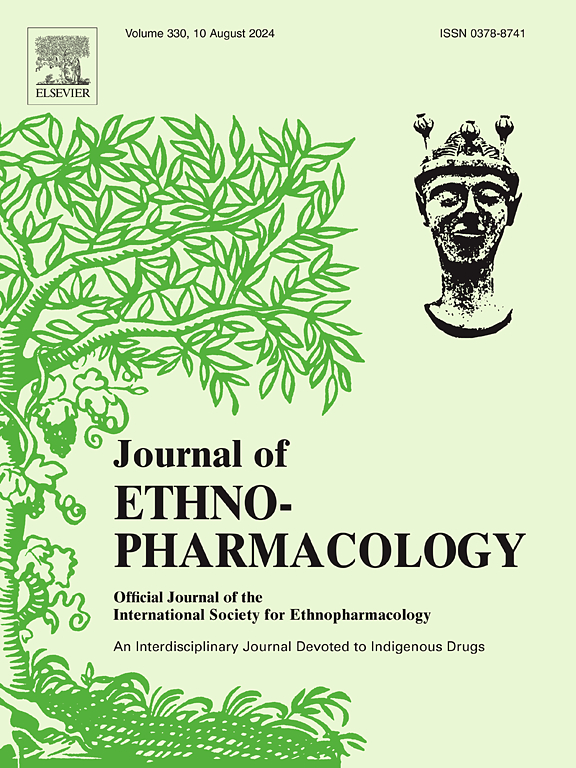Inhibiting multidrug resistant Shigella flexneri using comparative genomics guided In vitro and In silico screening
IF 5.4
2区 医学
Q1 CHEMISTRY, MEDICINAL
引用次数: 0
Abstract
Ethnopharmacological relevance
The Gram-negative bacterium Shigella is the most widely documented etiologic factor for diarrheal mortality in infants, contributing to 13.2 % of diarrheal episodes across the globe. The present surge in antibiotic resistance, increasing numbers of non-typeable strains, and the disparate regional distribution of multiple Shigella variants has rendered it obvious that novel therapeutic alternatives are desperately sought after to address the growing threat of shigellosis.
Aim of the study
In the present investigation, we have assessed the antibacterial properties of selected medicinal plants, against a naturally isolated, multidrug-resistant strain of Shigella flexneri, using different in-vitro susceptibility assays.
Materials and methods
We used virtual screening, molecular docking, and molecular dynamic simulation to quickly and accurately screen natural compounds derived from these plants for antibacterial agents. To further comprehend the antimicrobial mechanism of the herbal extracts and their active constituents against Shigella flexneri, a comparative transcriptome analysis and quantitative reverse transcription polymerase chain reaction (qRT-PCR) was undertaken to contrast and evaluate the differential patterns of gene expression between the treated and untreated populations.
Results
The findings deemed the two herbal extracts of Psidium guajava and Scoparia dulcis as a source of viable therapeutic candidates against the multi-drug-resistant strain.
Conclusions
The prospective active constituents, viz. 5-Hydroxy-1-isopropyl-6,6-dimethyl-5-phenyl-piperidin-2-one and limonene, and their corresponding therapeutic targets reported in this research, thus bring up the possibility of switching existing drugs with more potent phytopharmaceuticals for effectively controlling Shigella superbugs, awaiting further investigations.

利用比较基因组学指导体外和计算机筛选抑制多重耐药弗氏志贺氏菌
民族药理学相关性革兰氏阴性志贺氏菌是婴儿腹泻死亡的最广泛记录的病因,占全球腹泻事件的13.2%。目前抗生素耐药性激增,无法分型的菌株数量不断增加,以及多种志贺氏菌变体的不同区域分布,显然迫切需要寻找新的治疗方案来应对日益严重的志贺氏菌病威胁。在本研究中,我们利用不同的体外药敏试验,评估了选定的药用植物对天然分离的多重耐药弗氏志贺氏菌的抗菌性能。材料与方法采用虚拟筛选、分子对接、分子动力学模拟等方法,快速、准确地筛选从这些植物中提取的天然抗菌化合物。为了进一步了解中药提取物及其有效成分对福氏志贺氏菌的抑菌机制,采用比较转录组分析和定量逆转录聚合酶链反应(qRT-PCR)来对比和评估处理和未处理群体之间基因表达的差异模式。结果番石榴和茯苓两种草药提取物可作为抗多重耐药菌株的有效药物。结论本研究报道的潜在有效成分5-羟基-1-异丙基-6,6-二甲基-5-苯基-胡椒苷-2- 1和柠檬烯及其相应的治疗靶点,为利用更有效的植物药替代现有药物有效控制志贺氏菌超级细菌提供了可能性,有待进一步研究。
本文章由计算机程序翻译,如有差异,请以英文原文为准。
求助全文
约1分钟内获得全文
求助全文
来源期刊

Journal of ethnopharmacology
医学-全科医学与补充医学
CiteScore
10.30
自引率
5.60%
发文量
967
审稿时长
77 days
期刊介绍:
The Journal of Ethnopharmacology is dedicated to the exchange of information and understandings about people''s use of plants, fungi, animals, microorganisms and minerals and their biological and pharmacological effects based on the principles established through international conventions. Early people confronted with illness and disease, discovered a wealth of useful therapeutic agents in the plant and animal kingdoms. The empirical knowledge of these medicinal substances and their toxic potential was passed on by oral tradition and sometimes recorded in herbals and other texts on materia medica. Many valuable drugs of today (e.g., atropine, ephedrine, tubocurarine, digoxin, reserpine) came into use through the study of indigenous remedies. Chemists continue to use plant-derived drugs (e.g., morphine, taxol, physostigmine, quinidine, emetine) as prototypes in their attempts to develop more effective and less toxic medicinals.
 求助内容:
求助内容: 应助结果提醒方式:
应助结果提醒方式:


